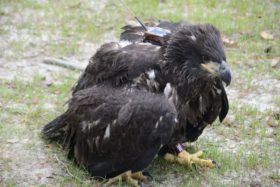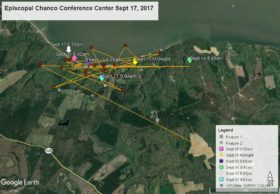Rare 4-Chick Bald Eagle Nest in Virginia
Azalea At Mackay Island NWR in NC
April 22, 2011Camellia Flies Back to York County, VA
April 25, 2011Extremely Rare Bald Eagle 4-chick Brood Documented on James River
On 18 April, 2011 while flying eagle productivity surveys along the James River, Dr Bryan Watts and Dr Mitchell Byrd from the Center for Conservation Biology and pilot Fuzzzo Shermer documented a 4-chick brood in a nest on Bailey’s Creek in Hopewell, Virginia. The breeding territory had been occupied for more than 10 years and the current nest is in the top of a large scarlet oak. The four chicks appeared in good condition and ranged in ages from approximately 32 to 42 days.
More than 8,000 breeding attempts have been monitored in Virginia as part of the annual survey and this is the first 4-chick brood ever documented in the state. As far as we are aware, this represents only the third 4-chick brood ever documented for this species. The first was in 1986 on the Eastern Shore of Maryland and the second was in 2009 in the water gap portion of the Delaware River.
Brood size is a life history trait that reflects a broad range of evolutionary tradeoffs. For many large raptors, sibling competition and brood reduction are behavioral mechanisms that maximize chick production under poor resource conditions. Under such conditions, sibling competition imposes downward pressure on brood size to match available resources. When resources are abundant and provisioning exceeds demand, sibling dominance hierarchies are relaxed, the last chick disadvantage is reduced, and brood reduction is less likely. Under such conditions, large clutches provide an advantage by allowing pairs to raise above-average broods
Bald Eagle broods hatch asynchronously, often form dominance hierarchies, and may exhibit brood reduction depending on prey availability. Under normal circumstances, the degree of hatching asynchrony for unusually large clutches likely creates such a disadvantage for the last chick that it sets an upper bound on brood size.
A perfect storm of conditions must come together in order for a Bald Eagle pair to raise four chicks to independence. The female must produce a four-egg clutch, the equivalent of 10% of her body mass, in a narrow time window. If the time span of laying is too long, the level of asynchrony will be too great for the forth chick to overcome. The female must brood and feed the older siblings for several days while maintaining the viability of the forth egg until hatching. Shortly after the last egg hatches, ambient conditions must allow for the female to leave the brood frequently enough to assist the male with foraging and provisioning. Lastly, foraging conditions must allow for high per capita provisioning rates to reduce the strength of a dominance hierarchy and the likelihood of brood reduction.

Photo credit – Dr Bryan Watts




22 Comments
Wonderful documentation – and pic! Thanks for the great info.
Wow…what an incredible find! I bet there was plenty of cheering going on in the plane. Amazing pic. Thanks for sharing the special details of the work you do – it is greatly appreciated, all the way from Ontario, Canada
Oh how wonderful!!!! Look at those four eaglets – good size and look about the same age as the NBG eaglets. What a thrill it must have been for Dr. Watts to see this. Thank you so so much for posting this and sharing with everyone. I know it will be the “talk of the blog” very soon.
What an amazing discovery! I wish the family the best. Mom and Dad must be REALLY busy! Thanks for all the work you do.
What wonderful information & picture. God is giving us humans a wonderful give. Lets not mess it up. Thank u’ll for ur hard work.
WOW! That is amazing. I’m sure everyone was very excited about this! This must be a terrific pair of parents as these eaglets all look to be healthy! A great picture! Thanks so much for sharing and for all the info on the rarity of a four egg nest!
What an exciting discovery! I really appreciate the explanation of the forces at work to limit the size of an eagle’s brood. We certainly see with the NBG eagles how important an abundant and easily available food source is, from how much the eaglets eat.
WOW is right ! Hope they fledge and live happily ever after.
Thanks Reese for posting.
Thanks Dr Watts and Dr Byrd for doing the survey.
All I can say is “WOW” thanks so much for all the work you guys do,what a wonderful story.
This is so amazing…love the plane shot. I’m wondering if there will be follow-up photos of this miraculous bunch of eaglets!?
Any speculation whether this pair is older or younger than the pair at NBG? and could the James River ecosystem possibly be richer than the waters around NBG?
Response – about the same age as NBG chicks
Someone is paying attention / thank you Dr. Watts & Dr. Byrd. Fascinating.
Was fortunate enuff to see a nesting pair of Bald Eagles on the Yellowstone R. this Morning; along with 43 other species on our YVAS Spring Birding Holiday… to Exxon Ponds in Billings, MT.
Wow, Wonderful article. Thank you for sharing. I’ve learned so much about Eagles in this past month!!
Thank you for all of the most amazing information that you provide us. This is so wonderful to know the eagles are prospering. This wouldn’t be happening if not for the wonderful work that you all do. Four babies must have been exhausting. The picture is beautiful.
What a great find and a testament to the work being done to protect and study these magnificent birds. Congrats on your find!
Thanks for sharing with us. Wow what a find! Congratulations to you and all involved.
Wow, how cool is this?!? I live in a city, so I can’t ever see things like this on my own. Loving it! Hard to believe they start out that small. 🙂
That is great to actually see via a photo!
What an unbelievable story, not only about the Eagles, but that it happened at Bailey’s Creek in Hopewell. I grew up there in the 60′ and 70’s. The area was so polluted that you could not eat the fish caught and for a while not swim in the James River. When Crossing Bailey’s Creek on Rt. 156, the smell was so bad that it turned my stomach.
So great to see that the pollution can be cleaned up.
After what has happened with the mom at NBG, this makes my heart sing, to see these 4 beautiful babies.
Amazing! Thank you for sharing.
Oh, and I forgot to say, as the youngest of four children who was picked on by my older siblings, this especially makes me smile.